Flexible bidding strategies are ways to automate rules around specific areas of your campaigns, ad groups, and keywords. These bidding strategies can help you improve conversion rates, boost keyword performance, and/or improve your return on ad spend. In the past, you had to choose between manual or automation, but now you have the flexibility to blend automation with manual bidding within multiple areas of your account.
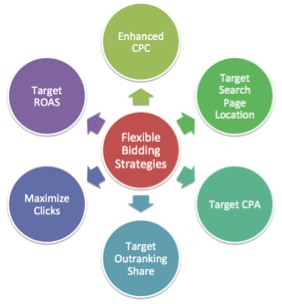
Google offers 6 flexible bidding strategies built to work around advertiser’s specific goals. Depending on your goals, you may or may not want to use one of these bidding strategies.
Most of us are already familiar with the standard bidding options:
- Manual CPC Bidding
- Automatic CPC Bidding
- CPA Bidding
Shortly after Google launched Enhanced Campaigns, the 6 flexible bid strategies were rolled out. These bid strategies were designed to merge automation with individual goals.
How To Apply The Bid Strategies
Bid strategies can be set-up in the Shared Library and can be applied to various levels of the account. You’ll need to select “Bid strategy” and then “Use flexible bid strategy.” Google will display any strategy if it is available at that level. Alternatively, you can select “Manage flexible bid strategies” and it will take you straight to the library to create or edit bid strategies. At the Campaign level, you are only able to change a bid strategy or manage existing strategies.
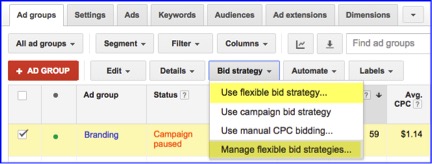
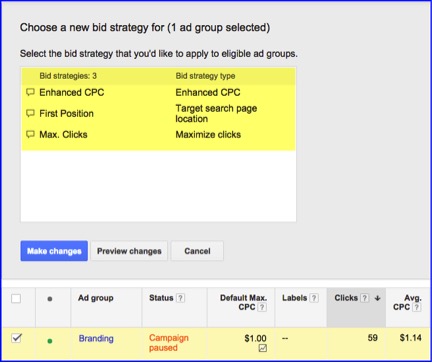
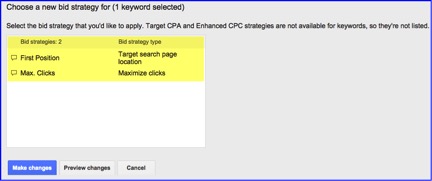
The 6 strategies are:
- Enhanced CPC (ECPC)
- Target search page location
- Target CPA
- Target outranking share
- Maximize clicks
- Target return on ad spend (ROAS)
Enhanced CPC (ECPC)
In order to use Enhanced cost-per-click (ECPC) bidding, you will need to set up conversion tracking. It is also advised that you have at least 15 conversions per campaign in order for the system to have enough data to make accurate adjustments. The system makes future predictions based upon historical data, so more data helps determine accurate adjustments.
When to Use: Conversions are the primary goal but control over bids is desired
Where Available: Campaigns and ad groups
When ECPC is enabled, Google will begin by adjusting only 50% of your keyword bids and using the other half as a control for comparison. The system will then raise your max CPC up to 30% on keywords it believes are more likely to lead to a conversion. The system is also able to lower bids by as much as 100% when it determines a keyword is unlikely to convert.
This option is best for accounts with high volumes of conversions like ecommerce or shopping accounts. This option may not be the best for advertisers trying to increase traffic volume or if you get a high percentage of in-store conversions.
Target Search Page Location
This option is for accounts wanting to be competitive for specific keywords where cost is not an issue. This might be a good option for someone who is interested in branding and wants to remain in the top positions for a highly competitive keyword.
When to Use: When your goal is to be in the top positions and cost is not an issue
Where Available: Campaigns, ad groups, and keywords
Google uses data from the last 7 days to determine the best CPC in order to achieve a top of page ad position. The system will also low your bids in order to keep you at the top position. You can set a max CPC bid in order to make sure the system does not spend more than you would like per click.
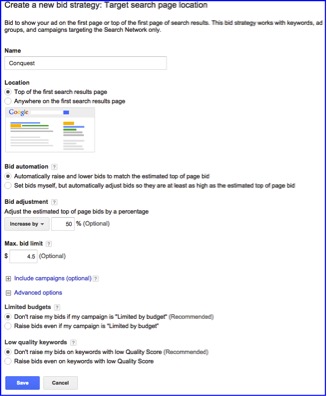
This strategy is great for campaigns where the advertiser has a specific keyword or group of keywords where they would like dominant positions. A great option for this scenario would be to create a separate campaign and isolate these keywords, allowing you to set-up different bids for other variations. Just remember to create exact negative keywords in the other campaigns.
This bidding option would not be good for accounts that are budget-constrained, focused on ROI or have strict CPA goals.
Target CPA
In order to use Target Cost-per-acquisition (CPA) bidding, you will need to setup conversion tracking and have at least 15 conversions in 30 days. This option allows Google to optimize your account for conversions at your desired CPA goal. It is best practice to set a maximum CPC bid otherwise you could end up paying more per click than necessary.
When to Use: When conversions are important at a specific threshold
Where Available: Campaigns and ad groups
The system will attempt to optimize the account for conversions instead of clicks. When you initially activate Target CPA bidding, Google will recommend a starting CPA bid based on historical performance. If you are willing to pay more you can raise the CPC to attempt to get more conversions. You can also lower the target CPA, but this may reduce the total number of conversions you achieve.
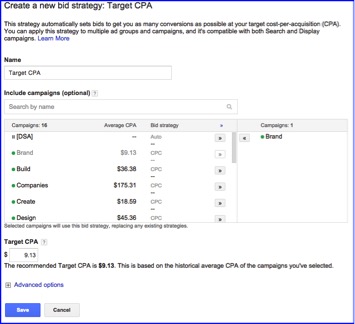
When you are using this bidding strategy you will want to focus on conversion volume. Cost-per-click (CPC) and average position may become less important. Also, keep in mind that accounts that desire more traffic, this option may actually reduce the number of auctions the ads are eligible to appear.
CPA bidding is not a good option for campaigns that receive a high volume of in-store traffic or less than 15 conversions per month. This option would not be good for accounts that receive a high volume of phone calls and are not using Google’s dynamic website call tracking.
Target Outranking Share
The Target Outranking Share option allows the system to automatically set bids to outrank a particular domain. This strategy is only available in the Search Network. In order to support this bidding strategy, make sure you have extra budget because bids will most likely be higher when trying to outrank other domains.
When to Use: When your goal is to outrank a specific domain & cost is not an issue
Where Available: campaigns, ad groups, and keywords
This bidding strategy helps you outrank a particular domain or appear in auctions the other domains do not appear. Keep in mind this does not guarantee your ad will always appear above the targeted domain. This option simply raises your bids and can help you improve your ad rank. It also will not show you in auctions your ads do not already participate.
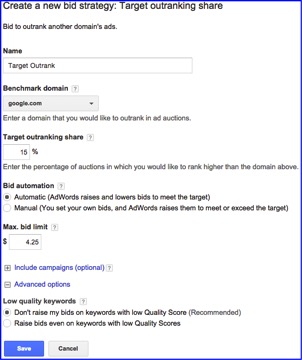
Keep in mind the final ad placement still depends on other auction factors and Quality Score. Also, it can be expensive to raise bids on low-quality keywords, so by default, the system is automatically set to not raise bids on these keywords. It is always advisable to set the highest max CPC in order to control how much you pay per click.
Using the Auction Insights Report, you can select from the list Google provides or you can manually enter a specific domain if it is not already listed. It can take up to 7 days before you see results and Google recommends giving it at least that long before changing your strategy again.
Maximize Clicks
The Maximize Clicks strategy is great for accounts trying to maximize traffic. The primary goal of this campaign is to increase traffic. By setting this bidding strategy, AdWords will automatically increase and decrease bids while remaining within a targeted budget. If you do not set a target spend, Google will try to get as many clicks as possible within your daily budget.
When to Use: When your goal is to get the most clicks within a specific budget
Where Available: Campaigns, ad groups, and keywords
When maximizing your clicks, it is always advisable to set bid limits when using this option, otherwise AdWords will set the bids for the amount that is likely to receive the most clicks. Setting max CPC bid can help you control CPC costs.
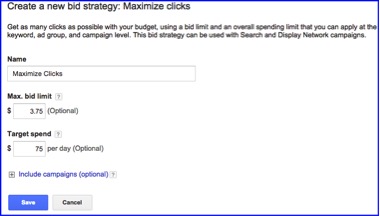
You can also set the target spend and AdWords will attempt to get as many clicks as possible within that set budget. However, in the event your target budget is set higher than your daily budget, the system will not spend more than the daily-allocated budget.
Target Return On Ad Spend (ROAS)
In order to Target Return on Ad Spend (ROAS), you must have set up conversion tracking and include set values per conversion. You will also need at least 15 conversions within the past 30 days. The more historical conversion data the system has the more accurate it can predict future performance.
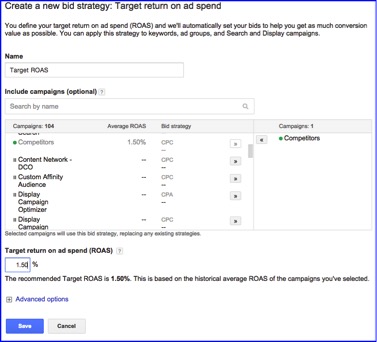
When to Use: When your goal is to balance profit-per-conversion & volume
Where Available: Campaigns, ad groups, and keywords
Target ROAS is perfect for advertisers who desire a balanced approach of return on investment and conversion volume. When setting up this option it is a good idea to use the historical cost-per-conversion value. You can find this data by multiplying the Conv. value/cost * 100 to get your Target ROAS percentage.
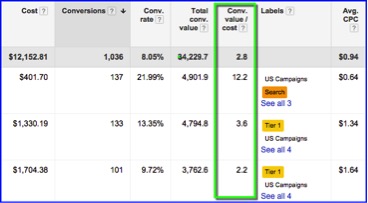
Under advanced settings, you are able to set max and minimum bid limits but Google advises against this option for target ROAS settings as it can prevent adjustments and limit performance. Also, any advanced bid limits will only be used in the Search Network.
Targeting Return on Spend is perfect for the advertiser who is looking to improve conversion volume at the same time while achieving a specific return on ad spend. This is especially useful for advertisers with multiple products that have different conversion values. AdWords will automatically bid up or down on specific keywords to help you achieve ROAS goals.



